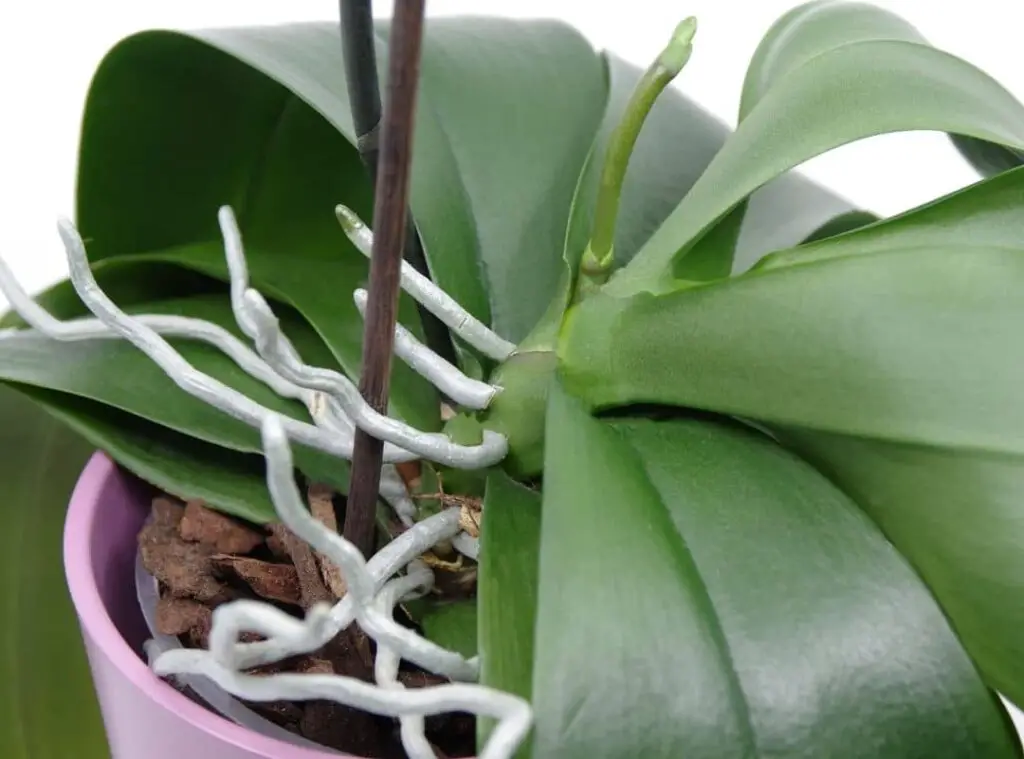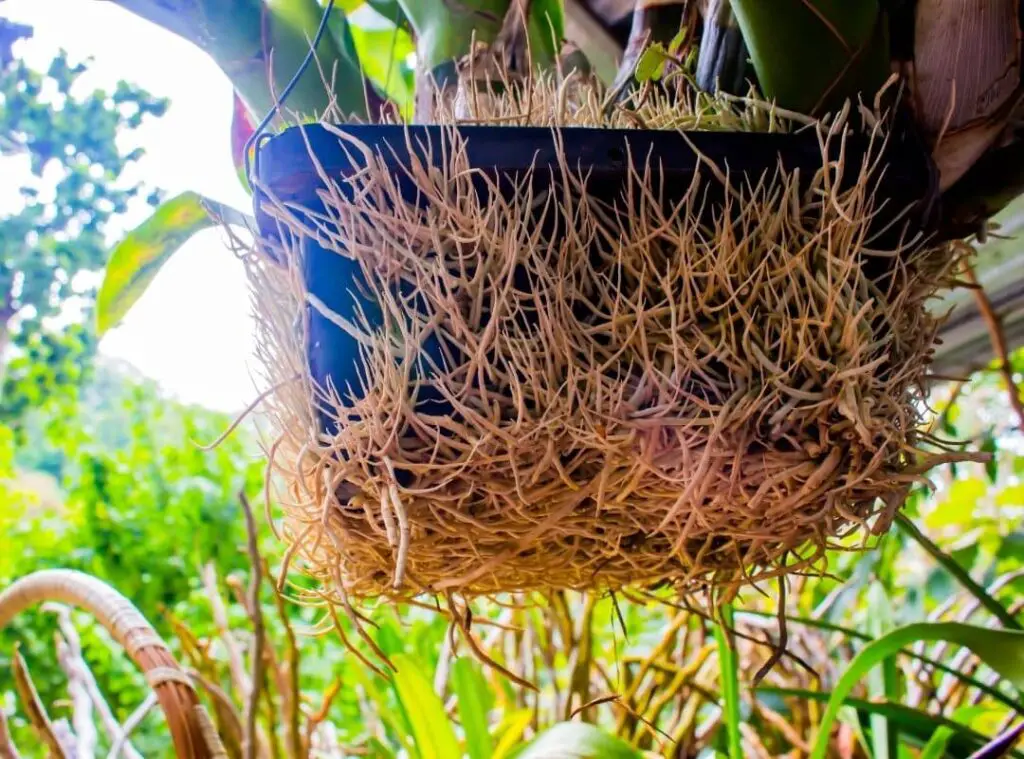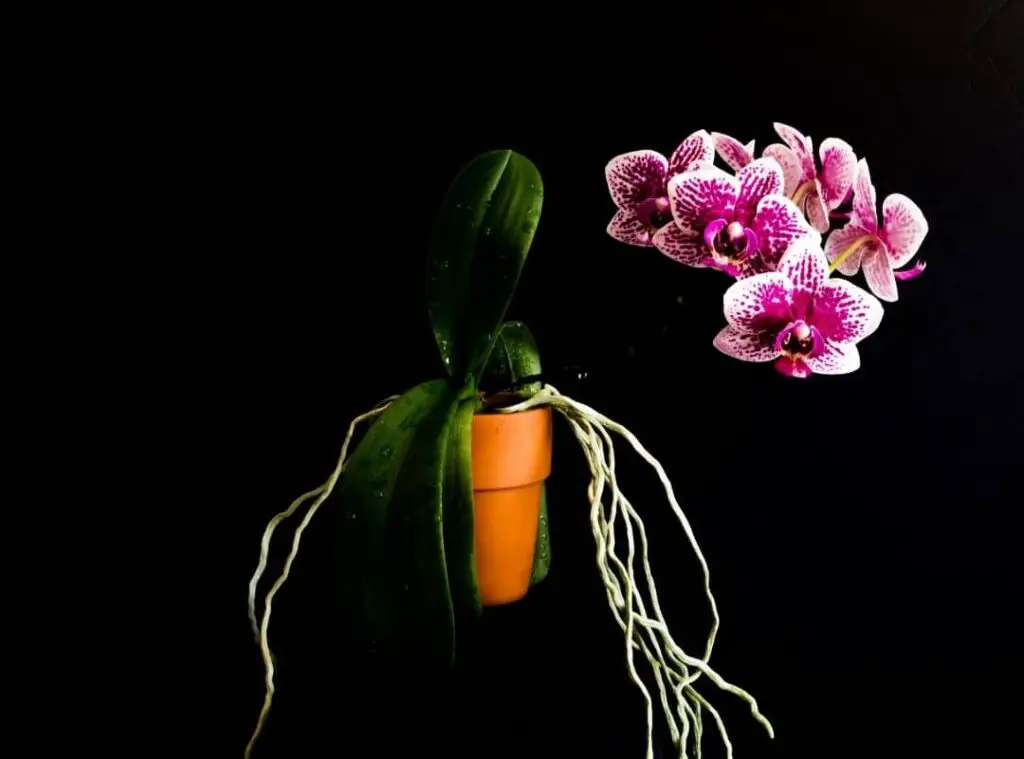There is nothing special you could do to stop orchid roots from exposing to outer air. It is their general behavioral. You could commonly spot the orchids forming exposed aerial roots.
Those roots would emerged from the pot right into the air. Once you spot them you will feel like you need to trim them off. However, that is an important phase of the orchid’s growth cycle.
When orchids are in their natural habitat, you could spot their roots emerging from the tree surfaces. That is where the orchid blooms also take place.
Further those roots would wind underneath moss and bark as well. That will make the plant stay firm. In addition to that, roots would be beneficial for nutrients absorption and for moisture absorption from the air .
If you could spot your orchid’s roots are firm and white in color, that literally means they are healthy. You need to avoid trimming them off. On the other hand, if they seem to be unhealthy, you need to trim them off.
As a gardener you love your plants. Similar to that if you interested to learn more about fish raring and caring please visit life of fish website for more details.

Get to know about orchid roots
If we take dead orchid roots, you could spot them in different ways. They are as follows,
Brittle roots
If your orchid contains roots which are dry and brittle, you may assume them as dead roots. Further you may spot them wrinkled when they have dried up. Moreover, you may spot them in yellow as well.
Black roots
If you could spot your orchid with black roots, you could take them as dead roots. Unfortunately, you cannot revive the plant no matter what you do.
It could be a reason for pest attack. In case if you wish to repot an orchid, which has dead roots, you need to first remove them and then proceed. Unless there is a potential for you to lose both the mother plant and the new plant.
Green and plump
If you could spot the green and plump roots, they are the healthy roots which have gotten water a little while ago. You should avoid them cutting or watering again.
Silvery or grey roots
Consider that you have an orchid which comprises silver or grey roots, that literally means they are doing well, but they would require some water though.
Brown roots
You need to take these roots from the orchid. However, this does not really mean those roots are dead and about to die. If you could spot your orchid has so many brown roots, that could be a repercussion of over watering, and which has led to root rot.
Yellow roots
if you have an orchid which has yellow roots, it is not an indication that your orchid is dying or not well. Literally those yellow roots are the roots which you have not given adequate sunlight.
Due to that, they have been unable to go through the photosynthesis process which would turn them green. As such, if you see any yellow roots which are plump you may assume they are healthy and avoid interrupting them.
White and crispy
When you try to touch the orchid, if you feel like they are dry and slender and gives you a crispy feeling that literally means they are dead and dry.
They have not received water for a prolonged period. Unfortunately, it is very unlikely that they could absorb water or nutrients going forward no matter in which way you provide them. You could take these roots safely without causing any harm to the plant.
Benefits of orchid roots
The most crucial job of the orchid roots are to absorb nutrients. In addition to nutrients, they are supposed to gain minerals and moisture as well.
Those will help to feed and hydrate the plant. Having said that, orchid roots absorb water for the plant, they use a different way of absorbing them when compared to other plants. They in fact form aerial roots and absorb nutrients from the air.
In addition to the aforesaid element’s absorption, it would make sure the orchid remains secure and steady too.
Moreover, the roots could store the additional nutrients as well. it would act as a food storage cellar and retain extra nutrients which would be beneficial during their lean times.

What Do healthy orchid roots look like?
If you want to identify the healthy orchid roots, they would be firm when you touch them. In terms of colors of healthy roots, they would be either white or green.
It is not necessary for the healthy roots to always remain bright green. You could expect them to be in bright green after you water them only.
In case you spot your orchid roots are bright green all the time, that literally means the plant is drowning. Chances are that those orchids would end up dying from over watering.
When it comes to the lengths of the healthy roots of the orchids, they could be different from one another. Widths of the healthy roots would also vary from one another.
Having said that, they still have some common characteristics.
You could usually spot them in green color. Chances are that you could spot them along with red tips as well. If you spot longer tipped roots, that indicates they are actively growing.
You may spot the velamen also in either white or in silvery colors. Moreover, you could feel them as spongy when you touch them.
That portion would form from the root bottom and spreads outwards to the tips of the leaves. However, the roots would be round in shape and plump. Further they would comprise green or red tips as well.

Special caring facts about orchid roots
It is important that you provide a clean pot. In addition to that, it should comprise a potting medium which is porous. Moreover, it has to be a fast-draining potting medium as well.
Soil quality
These are the most crucial factors when it comes to providing proper caring for orchid roots. Moreover, they would like soil which has a good aeration, and which is firm too. If you wish to make a potting medium on your own, you could do that as well.
Instead of that, you could purchase orchid specific potting mix as well. Those soil mixes would act in contrast with the rest of the traditional soil mix.
Light requirement
Make sure that you locate the orchid in plenty of indirect sunlight. However, if you locate these orchids under extreme direct sunlight, chances are that it could contribute to burns in the plant.
When you are growing them indoors, make sure that you locate it somewhere like near a window. Moreover, if the orchid is exposed to too much sunlight there, you could use a curtain and diffuse sunlight.
In addition to that they would enjoy growing in a frosted bathroom window as well. If not, you could grow them under a spot where they expose for sunny skylight.
As an alternative you may provide a plant light and supplement them with artificial light as well.
Humidity
You need to further be mindful in proving proper humidity level, proper temperature level. More importantly you need to ensure that you water them as appropriate too. Usually, orchids would survive in high levels of humidity.
Temperature
In terms of proper temperatures, it has to be ideally a temperature hovering around 75 degrees Fahrenheit during daytime. During nighttime they could survive in slightly lower temperatures.
When it comes to the autumn season, if we expose the orchids for temperatures below 55 degrees Fahrenheit.
Ensure that you do not let the orchid to either entirely. Best is to keep the bark potting medium moist. To do that you could soak the plant and drain it once every week.
Alternatively, you could water start watering the bark from top. Avoid spilling water on the leaves.
Read Next : Do orchids outgrow their pots? Easy 11 step Orchid Repotting Guide
